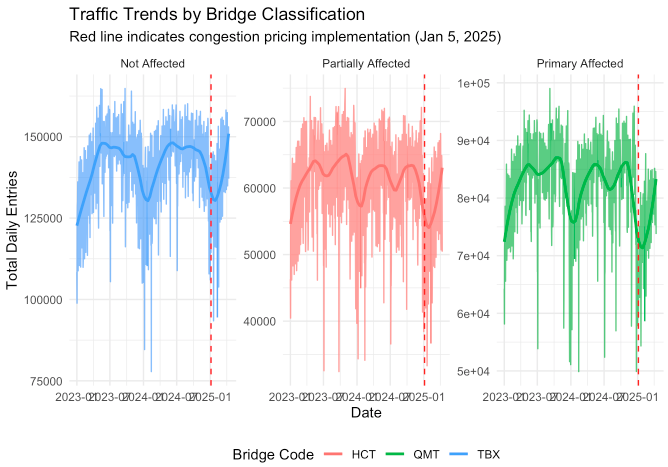Students in the M.S. in Quantitative Economics program apply their quantitative and analytical skills to real-world problems through coursework projects and independent research. Below is a selection of recent student work.
The Impact of New York’s 2025 Congestion Pricing on Traffic Volume
Authors: Chin Ting Wong and Marcus Nogueira

Spillover Effects: Changes in Total Traffic Volume Before and After Congestion Pricing by Bridge/Tunnel Impact Level
New York City implemented congestion pricing on January 5, 2025, charging vehicles entering Manhattan’s Central Business District during peak hours. This policy aimed to reduce traffic congestion, improve air quality, and generate revenue for public transportation improvements. Students Chin Ting Wong and Marcus Nogueira applied their MSQE training to evaluate this newly implemented transportation policy.
The students employed difference-in-differences methodology using high-frequency MTA traffic data from 2023-2025, focusing on the Queens Midtown Tunnel(QMT) as the primary treatment site. They utilized R programming for data processing and applied advanced econometric techniques including parallel trends testing, placebo tests, and spillover analysis. The research demonstrated sophisticated skills in causal inference, control group selection, and robustness checking.
The analysis revealed a statistically significant reduction of 135 vehicles per hour during pricing periods (p=0.03). Notably, traffic decreased during both pricing and non-pricing hours, indicating broader behavioral changes beyond simple time-shifting. Spillover analysis showed no significant traffic diversion to alternative routes, suggesting the policy reduced overall driving demand rather than displacing it.
These findings provide crucial early evidence for policymakers in NYC and other cities considering congestion pricing, demonstrating the students’ ability to conduct rigorous policy evaluation using real-world data.